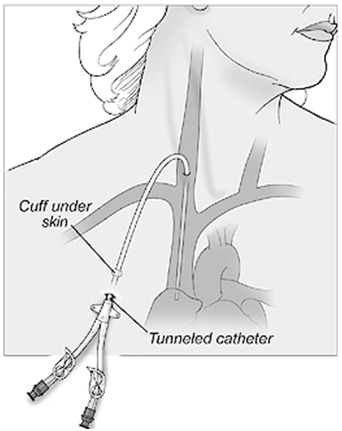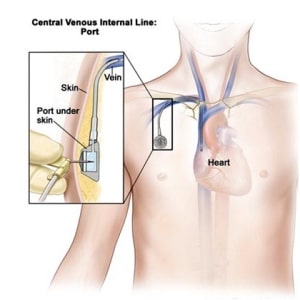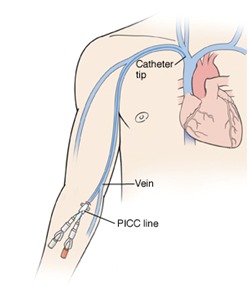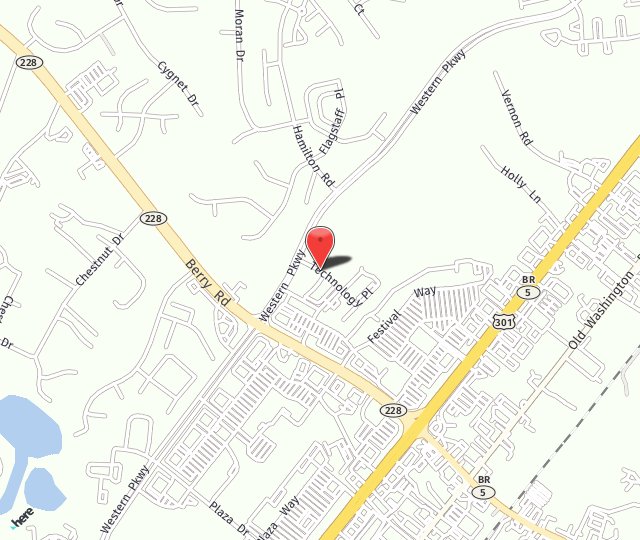Vascular access catheters can be placed for many reasons, such as intravenous antibiotic treatment, frequent blood draws, chemotherapy, dialysis, plasmapheresis, or IV feeding.
Tunneled Dialysis Catheters

A hemodialysis catheter is a hollow tube used for removal and replacing blood to and from your body. The catheter is tunneled from the internal jugular (IJ) with the tip entering the atrium of the heart. An exit site for the catheter is in the chest wall, under the collar bone. A small cuff on the catheter at the exit site sits under the skin. This cuff helps to keep the catheter in place, as well as, help prevent bacteria from entering the body.
The end of the catheter (outside of the exit site) known as a hub has 2 lumen. One lumen carries blood to the dialysis machine, while the other brings blood back into the body once it has been cleansed by the machine. Each lumen has a clip and an end cap that prevent air from getting into or blood from leaking out of the catheter.
Mediports
A port is a small device that is placed under the skin on your chest or arm. The port connects to a small, soft tube called a catheter which is placed inside one of the large central veins that take blood to your heart.
Patients can receive a number of medications infused through a mediport including chemotherapy. They can also be used for blood draws and transfusions, eliminating the need for multiple IV Sticks for a patient with frequent blood work and infusions. A port can stay in place for months or even years if needed.

Central Lines

Central lines are placed with the patient will need long term blood draws and or medication injections. This allows medical personnel to administer IV medications and blood draws without multiple needle sticks in your arms. Central lines can be tunneled and non-tunneled, implanted ports, or PICC (peripherally inserted central catheter) lines. They can have 1,2, or 3 lumens, depending on why central line is needed. The tip of the catheter is placed into the atrium of the heart with the exit site depending, as to what time of line is inserted. Tunneled and non-tunnel have exit sites at the neck, or chest wall area, while a PICC line’s exit is typically in the arm. The catheters ends have clips and caps that preventing blood from leaking out and air from entering the body.
How Long Can a Tunneled Dialysis Catheter Stay in?
The tunneled dialysis catheter may be cuffed or uncuffed. The uncuffed catheter is designed for short-term use; usually a month or less. A cuffed tunneled dialysis catheter is designed for long-term use. Your doctor may insert this catheter expecting you to use it for a few months or many years. This type of catheter becomes stabilized by tissue that grows onto the cuff of the device. In addition to stabilizing the catheter, the cuff also helps keep germs from entering the area and getting into the bloodstream.
Is There Downtime Needed After Receiving a Vascular Access Port?
The insertion of your dialysis catheter, mediport, or central line will most likely be done in an outpatient medical center. You'll be able to return home after we've confirmed that your vascular access has been inserted successfully and the effects of your anesthesia or sedation have worn off enough for you to be stable on your feet.
Before your treatment date, arrange to have someone accompany you to your appointment. They will need to drive you home. A seatbelt can compress your incisions where your port has been inserted, causing discomfort. Plan ahead for this by placing a small pillow or towel in the vehicle. This can be placed between your chest or arm and the seatbelt.
You may not need more than a day or two of relative downtime after your port or catheter is placed. You may return to work as soon as you feel well enough, provided that you are not required to push, pull, or lift heavy objects. Likewise, you should avoid strenuous exercise or other physical activities that could tug on, press on, or dislodge your catheter.
You may have some bruising and discomfort in the area where your catheter was inserted. You can take over-the-counter pain medication to address minor soreness and tenderness if needed. This should be needed only for two to three days. You can expect to be able to feel your catheter beneath your skin. You may see it as a slightly raised area, as well. However, this is hidden beneath clothing, so no one will see it as you do.
You may have special care instructions for your incision area depending on how your doctor has closed them. Bandages will cover the area to keep germs from reaching the incisions. Some bandages can be removed after a few days. Some, such as Dermabond, are made to come off naturally after seven to 10 days. It's important to avoid getting your bandages wet. Your aftercare instructions may provide tips for protecting the area, such as covering it well with plastic wrap, until the bandages are removed. If you have questions about how to care for your incision area after your catheter or port is placed, please reach out for assistance.
Schedule Your Consultation Today!
Interested in learning more about our services? Call 301-979-7078 to schedule your consultation with our providers today! Serving Waldorf, MD & all nearby areas.

